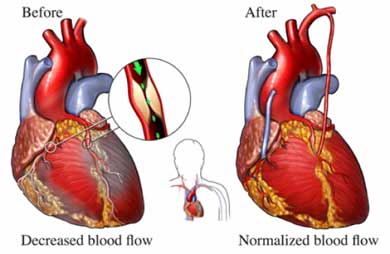Coronary Artery Bypass Grafting
Coronary Artery Bypass, a surgical procedure designed to restore circulation to the heart, will relieve or lessen the symptoms of coronary artery disease and improve the functioning of your heart. In this operation, a segment of artery or vein is attached to the aorta and then attached below the blockage into the coronary artery. This allows the blood to be taken directly from the aorta through the bypass, around the blocked coronary artery, which allows blood to flow to the heart muscle. One or more bypass grafts may be used depending on the number of diseased arteries. You may have two incisions from your surgery, one in the midline of your chest and other small incision(s) on the leg from which the vein graft was removed. A special instrument called an endoscope is used to remove the vein from your leg.
In addition to the segment of vein removed from the leg, the Internal Thoracic Artery (Mammary Artery) or the Radial Artery may be used as bypass grafts. The Mammary Artery lies beneath the breastbone, along with the inside of the chest wall. One or two mammary arteries may be used as bypass grafts. Utilizing the mammary artery will not require an additional incision. The radial artery is located in your forearm. Your body can easily compensate when these blood vessels are removed.

